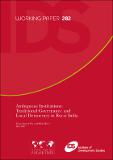| dc.description.abstract | ‘Customary village councils’ (CVCs) are widespread in rural India. They are generally
believed to be disappearing vestiges of a pre-democratic, hierarchical socio-political
order. In the Indian media, they are represented as instruments for the harsh
enforcement of ‘traditional’ norms of caste and gender inequality. However,
research in Karnataka state reveals a very different picture. CVCs are found in
almost every village. While continuing to resolve local disputes and exercise limited
judicial authority, they are actively taking on new roles, especially developmental
and electoral roles; becoming more pluralist and democratic; and providing a wide
range of services that are positively valued by villagers, especially by women. CVCs
often interact closely and synergistically with the formal, elected local councils
(Grama Panchayats ). This closely parallels other findings from empirical social
science research in India: an informal, ‘traditional’ institution, believed by
intellectuals and elites to be disappearing into the dustbin of history, turns out to
have considerable staying power, to be enjoying something of a revival, and to be
adapting to the democratic element in India’s modern, formal political institutions.
Analysis of data from a sample of 30 villages in Karnataka state collected over a
four-year period shows considerable inter-village variations in the activity levels of
CVCs. The most important single factor explaining this variation is the closeness of
their relationship to the formal, elected Grama Panchayats (GPs). The greater the
interaction between the two, the more active CVCs are. The paper concludes with
some speculations about why CVCs are so buoyant and active in this context,
while elsewhere similar ‘traditional institutions’ have been viewed as bulwarks of
inequality and hierarchy, and have generated considerable political opposition. One
major reason may be that CVCs operate in a relatively democratic and pluralist
environment in which the formal state provides many services quite effectively.
CVCs have no monopoly, and have continually to earn the authority which they
exercise.
Keywords: South Asia, India, decentralisation, governance, customary, panchayats | en_GB |

